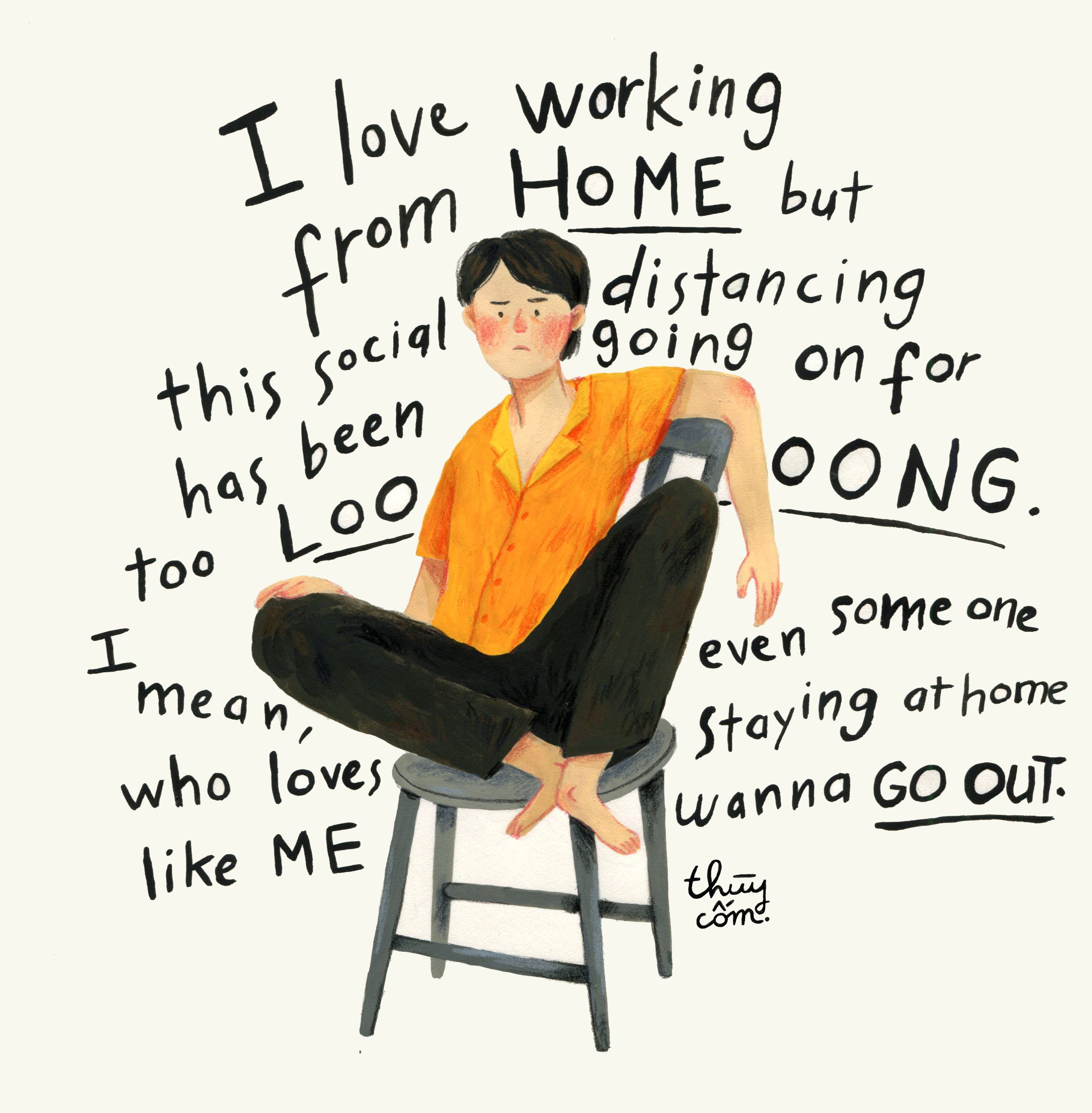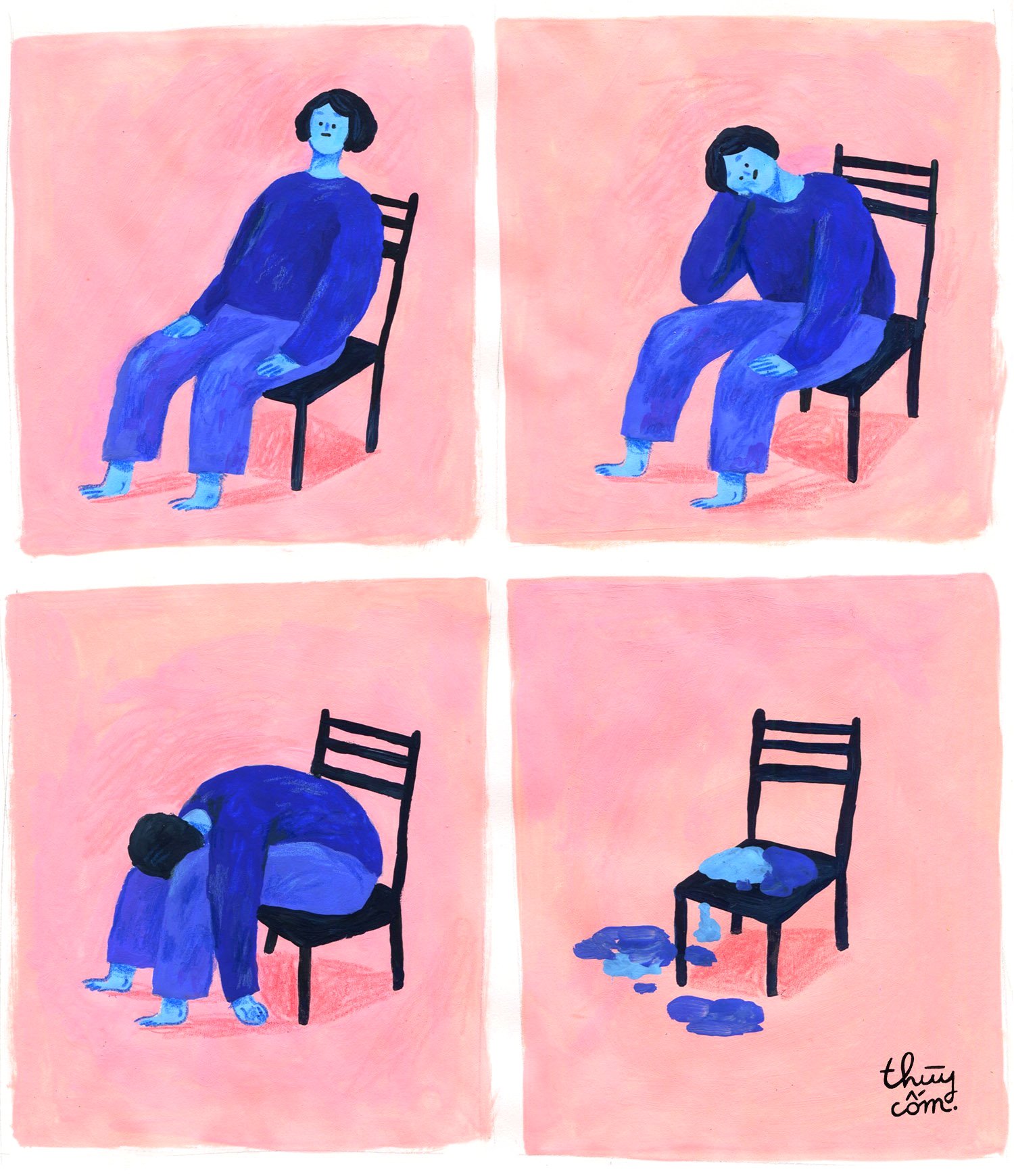Interview
Thuỳ Cốm
Thuỳ Cốm (Phạm Thu Thuỳ) is an author-illustrator of eight picture books, with three more scheduled for release soon.
She is also an illustrator of multiple books and commercial art, including One Stormy Night by Yūichi Kimura (Vietnamese version). She loves to tell stories about modest, beautiful, ridiculous, and frustrating things in life with a splash of fantasy and humor. She creates with both digital and traditional materials.
When not making picture books, Thuỳ Cốm writes culture and creative innovation columns for the Ministry of Science and Technology in Vietnam’s journal and hosts the Nghe nói là podcast.
She lives in Japan with her husband and has been trying every day to keep her plants alive.
What is your background and how did you start your journey in the art world?
“I was born and raised in Hanoi, Vietnam in the ’90s. I grew up in a house without any paintings or art books of any kind. My family never went to a museum or art exhibition. I started drawing in kindergarten, like any child at that age, and have been doing it ever since. When I was a kid, I drew all day long. Even though my family wasn’t rich, my father always bought me the best quality art materials he could find. I had the coolest art supplies in my class.
I learned to read at the age of 5. I often read alone, and my parents bought me any book I wanted. At an early age, I realized that what I loved the most was creating and visualizing stories. When I could read and write fluently, I wrote and illustrated my own stories in elementary school. I brought them to school and entertained my classmates.
In my last year of high school, I wanted to apply to art college but my parents opposed it. They wanted me to go to law or business school and get a stable job. At the time, I felt betrayed. Why did they invest willingly in my passion for art my whole childhood? After months of war and tears, my parents finally gave in and I went to art college for 5 years. I had my first picture book published, A toast for Sunny Day, when I was a second-year college student. It was based on an idea I’d had since high school. My parents never questioned my choices again.
After graduating, I worked as an editor-illustrator and deputy chief of a children’s book department at a publishing house for nearly 3 years. I learnt a lot about the publishing process and marketing, but I didn’t create much around this time. I quit the job and moved to Japan when I realized I wanted to focus on making my own creations.”
What inspires you most?
“There are two things that inspire me the most. First life itself, and at the same time, whatever helps me escape it. Since I was a kid, I’ve been told I’m too sensitive, and it was made to sound like a disadvantage. I guess in some cases it is. On other hand, it helps me feel things, no matter how small. What I feel I want to tell stories about, first to comfort myself, then to connect with others.
I always find it hard to meet people and make friends, especially in a new environment. I’m not good at socializing. From early on, I found out that I could express myself better through drawing and writing. People who like my works come to me and we become friends. In some ways, making art is the easiest way for me to have conversations and make connections.
Secondly, I’m greatly inspired by art in all forms: paintings, books, movies, and songs. Every time a work of art moves me, I have an urge to create something too. My first published picture book, A Toast for Sunny Day, was inspired by the Beatles’ song, Here Comes the Sun. I was listening to it one day and came up with an idea about a giraffe that ate the sun. I was a third-year high school student back then. Whenever I have art block, I’ll look for other artists’ artworks. Even if I can’t get over my art block, I feel satisfied just knowing I’m lucky enough to enjoy these amazing things.”
What themes do you pursue? Is there an underlying message in your work?
“I like the small and magical things in daily life. I find great joy in normal life, with its twists here and there. I draw a lot of food, people I know, and things I see everyday. Despite having a peaceful life, I’m not exactly a cheerful and optimistic person. But my strength lies in my ability to find humor in almost anything, under any circumstances. It makes me feel a bit stronger than I actually am. I’ve made funny comics while sobbing. I don’t think humor is a mask to cover sadness and pain, but something to encourage us. Like in Harry Potter, we defeat what we’re scared of the most by turning it into something ridiculously funny.
Most of my stories have a modern setting and a normal daily life premise, but then comes the twist. In Greeny’s Green Day, a small girl hated taking noon naps, so she ran away then turned into a tree, since trees don’t sleep. I once got feedback about the book from the mother of a little reader. She loved the story so much that she insisted on taking the book to bed to sleep with. That was one of the most precious pieces of feedback ever.”
How would you describe your work?
“This might not the best description, but I have goals for my work. There are three factors I aim for while creating: authenticity, humor, and modesty.
I’m surely not a skillful artist, but I seek relatability when making art. I believe that we have more things in common than we think, no matter where we’re from. The differences are easy to see and, most of the time, are overemphasized. Finding empathy is important.”
Which artists influence you most?
“These are a few of my biggest influences: Claude Monet, Taizi Harada, Jean-Jacques Sempé, Pierre Culliford (Peyo), and Matsumoto Taiyou. They all have very different art styles. Some are fine art artists, and some are comic or manga authors. I love their sense of humor and how they observe and interpret daily life.”
“I don’t think I could make something that would change the world; I don’t have any big and important message in my works.
But I want to create a little humble feel-good thing each day — to have a good laugh or a good sleep.”
What is your creative process like?
“I always start by making random sketches with pencil, like a warm-up routine. When I come up with a new idea or get an author’s manuscript, I try to get a specific visual to capture the vibe of the story. It can be a scene with the main character, a scenery where the story happens, or an outfit. I often start with the character: who are they, how they look, how they act, and so on. After I have the final character’s design, I move on to creating a rough storyboard, working on the flow of the story. I try not to get lost in small details too soon.
After getting the flow, I start testing materials and color palettes. I work with both digital and traditional materials, depending on the book I’m working on. Most of my published works are digital, but I’m leaning to traditional materials for future projects.
For me, the most interesting part in making a picture book is creating subtle details. Those details aren’t necessarily related to the main plot. It’s like hiding Easter eggs in each illustration.”
What is an artist’s role in society and how do you see that evolving?
“When I studied aesthetics theory at college, we had a debate about whether art is created for the sake of humans or just for art itself. I believe that a great piece is still great, even when no one appreciates its beauty. On the other hand, I see how art affects my life, and how much I wish my art could help someone.
There’s an anime movie I really like called The Girl Who Leapt Through Time. The main male character is a time traveler. He does everything to travel back to the past to see a painting which was destroyed before his time. It’s something that I can really relate to. Though art treasures of the world stand the test of time, I’d like to have seen them in their prime. The nowness has great meaning to me. It’s the connection between the artist, their work, and the present society.
Art is becoming a part of daily life for the average person. In previous centuries, art seemed to be only for the rich and powerful. Today, we even use classical art for memes, which I love. As artworks become more personal, and sometimes hilarious, people are connected in a whole new way. Before, when I went to art exhibitions or museums, I could only see artworks from a distance. But nowadays, there are more exhibitions and museums where I can touch and play with the art. Art isn’t just beauty for the eyes or a record of time—proof of historical events or religions and politics—but can also be a toy; an experience that stimulates all senses.”









